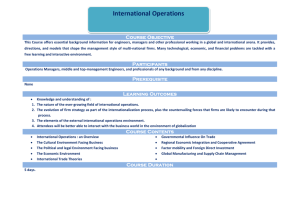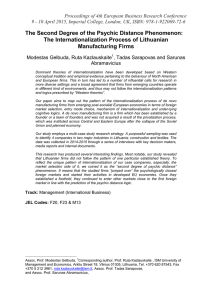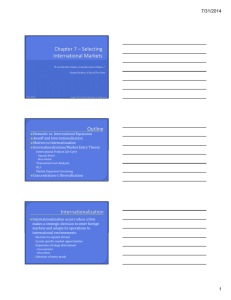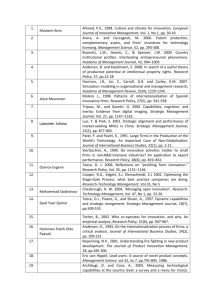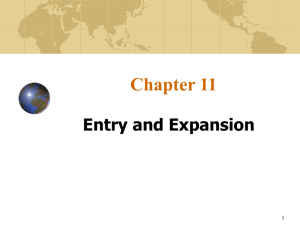Chapter 2
advertisement
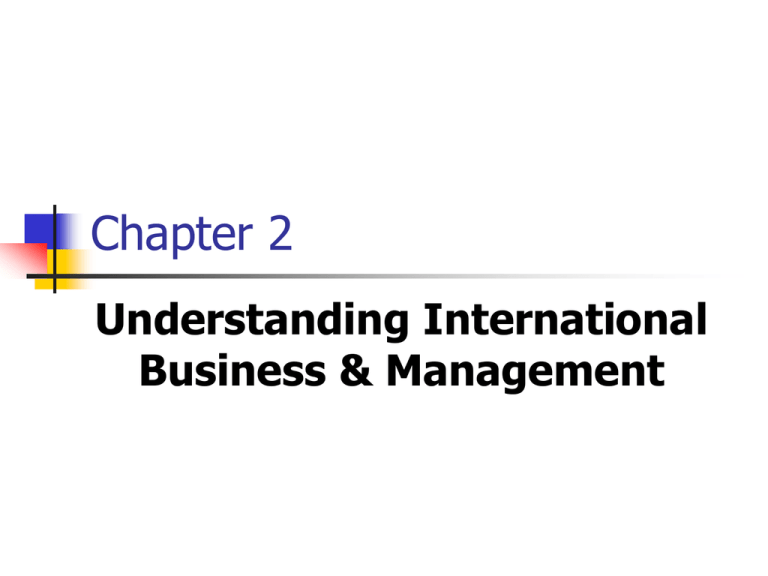
Chapter 2 Understanding International Business & Management International Business Any sort of business activity that crosses national boundaries. The economic system of exchanging good and services, conducted between individuals and businesses in multiple countries. Activities relating to industry and commerce performed on an international level. 2 International Management International Management- Process of applying management concepts and techniques in a multinational environment. 3 What is the deference between domestic and International business? Domestic Business International Business Same Basic Functions Processes Difference Environment within which these functions are performed and processes are carried out. 4 Why Internationalization? -The Trends Intense competition among industries, firms and countries on a global level is a recent development. The present trends are towards the increasing globalization and interdependence of firms, markets and countries. In a bid to meet commitments to institutions like WTO, IMF and WB, country after country is pulling down barriers to foreign trade and investment. 5 There is a growth of organization and administrative structures to manage resources and risks across national boundaries. Quantitative restrictions on foreign trade are being dismantled speedily and tariff barriers are on the decline. New opportunities to foreign investors and entrepreneurs are being provided to operate in the countries. 6 Reasons to become international Desire for continued growth Domestic market saturation Unsolicited foreign order Potential to exploit new technological advantage 7 Internationalization Pull factors (Proactive reasons) Push Factors (Reactive reasons) Pull factors are forces of attraction which pull the business to the foreign markets. Push factors are forces of compulsion which prompt companies to internationalize. 8 Pull Factors Relative Profitability Growth Prospects Push Factors Domestic market constraints Competition 9 Profit Advantage: Even when international business is less profitable than the domestic, it would increase the total profit. The AC per unit will be lowest if the plants is operated at optimum capacity OQ1 Domestic demand constraint makes it to produce OQ and hence AC is OC or QR much higher than OC1 or Q1I. AC to the extent of CC1 can be reduced by exporting QQ1 amount and the profitability will increase per unit by CC1 per unit. 10 R AC C I C1 0 Q Q1 11 Growth Opportunities: MNCS are getting increasingly interested in a number of developing countries due to the rapid rise of income and population in these countries. 1 billion people estimated to be added to the world population between 1999 and 2014. For going international is to take advantage of the opportunities in other countries 12 Domestic Market Constraints: Domestic demand constraints drive many companies to expand the market beyond the national border. FS Sale TS DS 13 For Example: Nestle derives only about 2% of its total sales from its to home market, Switzerland. For Philips, only 8 % of the total sales coming from the home market, Holland, but many different subsidiaries of Philips have contributed much larger share of the total revenues than the parent company. 14 Competition Protected market does not normally motivate Companies to seek business outside the home market. Economic liberalization brings competition from foreign firms as well as from those within the country. Companies take an offensive international competitive strategy by way of counter competition. To penetrate the home market of the potential foreign competitor so as to diminish its competitive strength & to protect domestic market share. 15 Dimensions of Internationalization Inward-looking (Impact of global competitors on domestically oriented firms) Outward-looking (Nature of competition in foreign market) 16 Inward-looking ( Impact of global competitors on domestically oriented firms) 1. 2. 3. 4. Importing/sourcing Acting as Licensee from a foreign company Establishing JV inside the home country with foreign companies Managing as a wholly owned subsidiary of a foreign firm. 17 Outward-Looking (Nature of competition in foreign market) 1. 2. 3. 4. Exporting Acting as Licensor to a foreign company Establishing JV outside the home country with foreign companies Establishing wholly owned business outside the home country. 18 Managerial Issues on Production and Sourcing From where should the firm supply the target market? To what extent should the firm itself undertake production? To the extent that it does not, what and where should it buy from others? To the extent that a firm opts to do at least some manufacturing, how should it acquire facilities. Should the firm produce in one plant or many, related or autonomous? What sort of technology should it use? Where should research and development be located? 19 Review Define International business. Discuss the forces driving companies towards International business. 20

